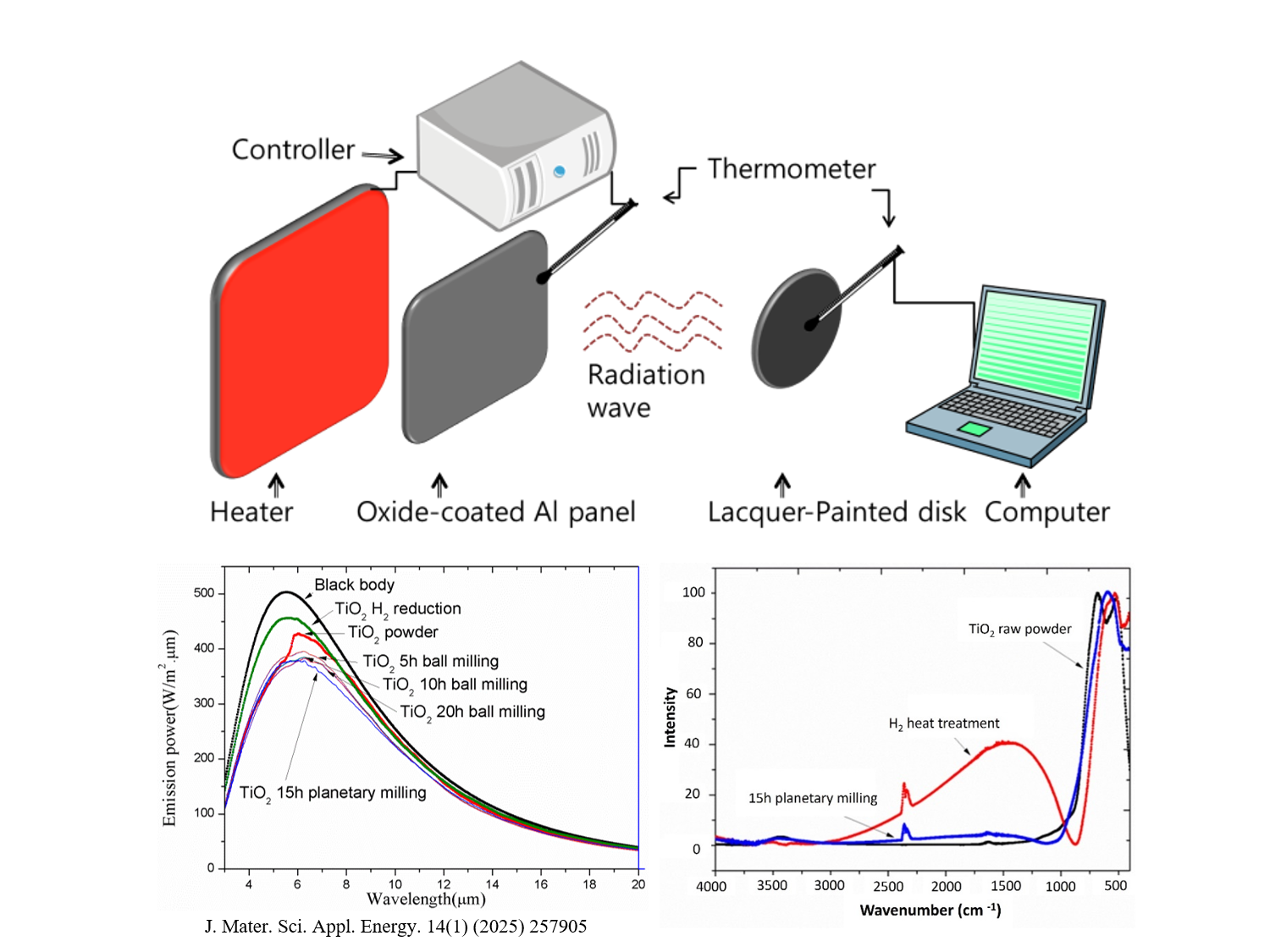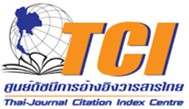Effects of defect density on the FIR radiation spectra of anatase TiO2 powder
Keywords:
Far-infrared radiation, Energy level, DV-X, TiO2, Electron statesAbstract
Anatase TiO2 powder shows an excellent emissivity of 0.916 over the wavelength range of 7–20 µm at 250°C; however, it shows a relatively low emissivity of 0.767 over the range of 3–7 µm. We investigated the effect of structural defects on the radiation properties of anatase TiO2 powder by introducing point and line defects into the system. The emissivity over the range of 3–7 µm increased from 0.767 to 0.902 upon the introduction of appropriate quantities of oxygen vacancies. This result suggested that the radiation properties are related in part to electronic transitions and could be significantly improved by optimizing the crystallinity of the host material. The results from X-ray diffraction (XRD), Fourier-transform infrared spectrometer (FT-IR), and Raman spectroscopy were used to explain the observations, along with predictions by a discrete variational X-α (DV-Xa)molecular orbital simulation.
References
E. H. Putley, History of infrared detection—part I. The first detectors of thermal radiation, Infrared Phys. 22(3) (1982) 125 – 131.
J. F. Lehmann, D. R. Silverman, B. A. Baum, N. Kirk, V.C. Johnston, Temperature distributions in the human thigh, produced by infrared, hot pack and microwave applications, Arch. Phys. Med. Rehabil. 47(5) (1966) 291 – 299.
Y. Liu, Y. Zeng, X. Hu, X. Sun, Effect of ultrasonic power on water removal kinetics and moisture migration of kiwifruit slices during contact ultrasound intensified heat pump drying, Food Bioproc. Tech. 13 (2020) 430 – 441.
Y. H. Liu, X. F. Li, S. Miao, Y. Yin, W. K. Zhu, Ultrasonic-far-infrared radiation drying characteristics and microstructure of pumpkin slices, J. Agric. Eng. 32(10) (2016) 10.
Wu, B., Guo, X., Guo, Y., Ma, H., & Zhou, C. Enhancing jackfruit infrared drying by combining ultrasound treatments: Effect on drying characteristics, quality properties and microstructure, Food Chem. 358 (2021) 129845.
X. Shi, Y. Yang, Z. Li, X. Wang, Y. Liu, Moisture transfer and microstructure change of banana slices during contact ultrasound strengthened far-infrared radiation drying, Innov. Food Sci. Emerg. Technol. 66 (2020) 102537.
H. P. Baltes, F. K. Kneubühl, Spectral distribution of cavity black body radiation in the far infrared, Phys. Lett. A. 30(6) (1969) 360 – 362.
E. M. Sparrow, Radiation heat transfer, Routledge, 27 April 2018, (2018).
A. Leupin, H. Vetsch, F. K. Kneubuehl, Investigation, comparison and improvement of technical infrared radiators. Infrared physics, 30(3) (1990) 199 – 258.
Y. M. Ke, M. C. Ou, C. K. Ho, Y. S. Lin, H. Y. Liu, W. A. Chang, Effects of somatothermal far‐infrared ray on primary dysmenorrhea: a pilot study, J. Evid. Based Complementary Altern. Med. (1) (2012) 240314.
T. M. Silva, G. A. Moreira, A. A. J. Quadros, M. Pradella-Hallinan, S. Tufik, A. S. B. Oliveira, Effects of the use of MIG3 bioceramics fabrics use-long infrared emitter-in pain, intolerance to cold and periodic limb movements in post-polio syndrome, Arq. Neuropsiquiatr. 67 (2009)
– 1053.
T. K. Leung, C. H. Kuo, C. M. Lee, N. W. Kan, C. W. Hou, Physiological effects of bioceramic material: harvard step, resting metabolic rate and treadmill running assessments, Chin. J. Physiol. 56(6) (2013) 334 – 40.
R. F. Nunes, F. J. Cidral-Filho, L. J. Flores, F. Y. Nakamura, H. F. Rodriguez, F. Bobinski, L. G. Guglielmo, Effects of far-infrared emitting ceramic materials on recovery during 2-week preseason of elite futsal players, J. Strength Cond. Res. 34(1) (2020) 235 – 248.
L. Zhang, P. Chan, Z. M. Liu, L. L. Hwang, K. C. Lin, W. P. Chan, C. S. Choy, The effect of photoluminescence of bioceramic irradiation on middle cerebral arterial occlusion in rats, J. Evid. Based Complementary Altern. Med. (1) (2016) 7230962.
T. K. Leung, Y. S. Lin, Y. C. Chen, H. F. Shang, Y. H. Lee, C. H. Su, T. M. Chang, Immunomodulatory effects of far-infrared ray irradiation via increasing calmodulin and nitric oxide production in raw 264.7 macrophages, Biomed. Eng. - Appl. Basis Commun. 21(05) (2009) 317 – 323.
D. Lee, Y. W. Kim, J. H. Kim, M. Yang, H. Bae, I. Lim, J. H. Ko, Improvement characteristics of bio-active materials coated fabric on rat muscular mitochondria, Korean J. Physiol. Pharmacol., KJPP. 19(3) (2015) 283.
R. F. Rosas, A. A. Emer, A. P. Batisti, D. D. Ludtke, B. L. Turnes, F. Bobinski, D. F. Martins, Far infrared-emitting ceramics decrease Freund’s adjuvant-induced inflammatory hyperalgesia in mice through cytokine modulation and activation of peripheral inhibitory neuroreceptors, J. Integr. Med. 16(6) (2018) 396 – 403.
Y. Chang, The effect of far infrared radiation therapy on inflammation regulation in lipopolysaccharide-induced peritonitis in mice, SAGE Open Med. 6 (2018) 050312118798941.
S. Fujita, Y. Ikeda, M. Miyata, T. Shinsato, T. Kubozono, S. Kuwahata, C. Tei, Effect of Waon therapy on oxidative stress in chronic heart failure, Circ. 75(2) (2011) 348 – 356.
T. K. Leung, Y. S. Lin, C. M. Lee, Y. C. Chen, H. F. Shang, S. Y. Hsiao, J. S. Chao, Direct and indirect effects of ceramic far infrared radiation on the hydrogen peroxide-scavenging capacity and on murine macrophages under oxidative stress, J. Med. Biol. Eng. 31(5) (2011) 345 – 51.
K. Yamashita, The effects of the far-infrared ray (FIR) energy radiation on living body, Blood Cell-An Overview of Studies in Hematology (2012) 21 September 2012.
L. Peng, B. Su, A. Yu, X. Jiang, Review of clothing for thermal management with advanced materials, Cellulose. 26 (2019) 6415 – 6448.
A. Martínez Nova, F. Marcos-Tejedor, B. Gómez Martín, R. Sánchez-Rodríguez, E. Escamilla-Martínez, Bioceramic-fiber socks have more benefits than cotton-made socks in controlling bacterial load and the increase of sweat in runners, Text. Res. J. 88(6) (2018) 696 – 703.
T. Harifi, M. Montazer, Application of nanotechnology in sports clothing and flooring for enhanced sport activities, performance, efficiency and comfort: a review, J. Ind. Text. 46(5) (2017) 1147 – 1169.
P. H. Hoet, I. Brüske-Hohlfeld, O. V. Salata, Nanoparticles–known and unknown health risks, J. Nanobiotechnology. 2 (2004) 1 – 15.
G. P. Dransfield, Inorganic sunscreens, Radiat. Prot. Dosimetry. 91(1-3) (2000) 271 – 273.
S. L. Schneider, H. W. Lim, A review of inorganic UV filters zinc oxide and titanium dioxide, Photodermatol. Photoimmunol. Photomed. 35(6) (2019) 442 – 446.
C. Cole, T. Shyr, H. Ou‐Yang, Metal oxide sunscreens protect skin by absorption, not by reflection or scattering. Photodermatology, Photodermatol. Photoimmunol. Photomed. 32(1) (2016) 5 – 10.
K. Vos, H. J. Krusemeyer, Reflectance and electroreflectance of TiO2 single crystals. I. Optical spectra, J. Phys. C: Solid State Phys.10(19) (1977) 3893.
J. F. Muth, R. M. Kolbas, A. K. Sharma, Oktyabrsky, S., & Narayan, J. Excitonic structure and absorption coefficient measurements of ZnO single crystal epitaxial films deposited by pulsed laser deposition, J. Appl. Phys. 85(11) (1999) 7884 – 7887.
T. G. Smijs, S. Pavel, Titanium dioxide and zinc oxide nanoparticles in sunscreens: focus on their safety and effectiveness, Nanotechnol. Sci. Appl. (2011) 95 – 112.
T. Hoang-Minh, T. L. Le, J. Kasbohm, R. Gieré, UV-protection characteristics of some clays, Appl. Clay Sci. 48(3) (2010) 349 – 357.
E. F. Bernstein, H. W. Sarkas, P. Boland, Iron oxides in novel skin care formulations attenuate blue light for enhanced protection against skin damage, J. Cosmet. Dermatol. 20(2) (2021) 532 – 537.
H. Yin, P. S. Casey, M. J. McCall, Surface modifications of ZnO nanoparticles and their cytotoxicity, J. Nanosci. Nanotechnol. 10(11) (2010) 7565 – 7570.
P. Porrawatkul, P. Nuengmatcha, A. Kuyyogsuy, R. Pimsen, P. Rattanaburi, Effect of Na and Al doping on ZnO nanoparticles for potential application in sunscreens, J. Photochem. Photobiol. B. 40 (2023) 112668.
C. Kormann, D. W. Bahnemann, M. R. Hoffmann, Environmental photochemistry: Is iron oxide (hematite) an active photocatalyst? A comparative study: α-Fe2O3, ZnO, TiO2, J. Photochem. Photobiol. A Chem. 48(1) (1989) 161 – 169.
S. Lee, Y. Kim, S. Kang, Far-infrared emission of Ti-based oxides, J. Mol. Struct. 987(1-3) (2011) 86 – 90.
H. Adachi, M. Tsukuda, C. Satoko, Discrete variational Xα cluster calculations. I. Application to metal clusters, J. Phys. Soc. Jpn. 45(3) (1978) 875 – 883.
M. Tsukada, C. Satoko, H. Adachi, Theory of the Surface Electronic Structure and Defect States of Rutile by the DV–Xα Cluster Calculation, J. Phys. Soc. Jpn. 47(5) (1979) 1610 – 1619.
J. C. Slater, A simplification of the Hartree-Fock method. Physical review, 81(3) (1951) 385.
D. E. Ellis, H. Adachi, F. W. Averill, Molecular cluster theory for chemisorption of first row atoms on nickel (100) surfaces, Surf. Sci. 58(2) (1976) 497 – 510.
J. K. Wilmshurst, Vibrational spectra of inorganic molecules: Part I. antimony pentachloride, antimony trichloride, zirconium tetrachloride, and ferric chloride, J. Mol. Spectrosc. 5(1-6) (1961) 343 – 354.
N. Hosaka, T. Sekiya, C. Satoko, S. Kurita, Optical properties of single-crystal anatase TiO2, J. Phys. Soc. Jpn. 66(3) (1997) 877-880.
H. Nakamatsu, H. Adachi, S. Ikeda, Electronic structure of the valence band for perovskite-type titanium double oxides studied by XPS and DV-Xα cluster calculations, J. Electron Spectros. Relat. Phenomena. 24(2) (1981) 149 – 159.
I. Nakagawa, S. I. Mizushima, A. J. Saraceno, T. J. Lane, J. V. Quagliano, Infrared absorption spectra of inorganic co-ordination complexes—XV: Normal vibrations of sulfamic acid, H3N+—SO3−, Spectrochim. Acta. 12(2-3) (1958) 239 – 243.
P. Strobel, Y. Le Page, Growth of Ti/sub9/O/sub 17/crystals by chemical vapor transport. J. Cryst. Growth;(Netherlands). 56(3) (1982).
T. Ohsaka, F. Izumi, Y. Fujiki, Raman spectrum of anatase, TiO2, J. Raman Spectrosc. 7(6) (1978) 321 – 324.
R. J. Butcher, W. J. Jones, Cyclopropane: Studies of some vibration-rotation Raman bands, J. Mol. Spectrosc. 47(1) (1973) 64 – 83.

Downloads
Published
How to Cite
Issue
Section
License
Copyright (c) 2024 Journal of Materials Science and Applied Energy

This work is licensed under a Creative Commons Attribution-NonCommercial-NoDerivatives 4.0 International License.







